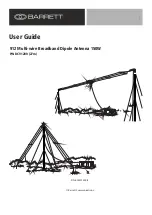
The traps are constructed from capacitors and an inductor (coil) to form a resonant circuit. Two 27pF capacitors are
placed in series by soldering to the long circuit boards and connected in parallel with the loading coils to form the
traps.
Trap Capacitors
Insert the capacitors into the long circuit boards in the marked positions.
Before soldering, bend the leads over as shown below so that the capacitors lie flat on the board. This is to allow
them to fit inside the coil forms.
Solder the capacitors and trim the excess leads so that the board appears as shown in the photo above.
Trap Coils
The coils use the 10’ 4” sections of wire that were prepared previously to wind coils with 51 turns.
Start by inserting the wire through one of the holes of the coil form leaving about 2”.
Wind the coils counting one turn each time the wire passes the starting point. Keep the wire as tight as possible and
the turns together during winding.
You can tighten the coil by holding one end and with the other hand, twisting the wire on the form in the direction
of winding to remove slack.
Double check by counting the turns to verify the total number of turns is 51 before cutting off the excess wire in
the next step. A turn is counted as each time the wire passes the starting point as it wraps around the coil support
tube.
Note: Tape may be helpful to temporarily hold the turns in place while winding.
Trap Assembly
Trim the leads of the coils to approximately 1 inch and strip the insulation leaving approximately 3/8 to 1/2 inch of
the insulation past the coil ends as shown below.
2040DipoleV2_20180214
3
























